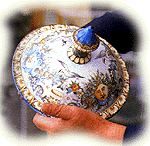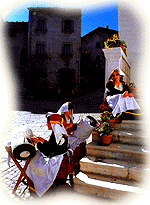 |

|
|
CRAFT CENTRES |
|
| Abruzzo is a land rich in civilization and old traditions, where it is absolutely essential to get to know the places associated with crafts. In this way one can discover villages where, over the centuries, there has been a proliferation of little workshops where people were beating iron and copper, carving and turning wood, or modelling ceramic vases and other objects. In these workshops humble craftsmen were trained, some of whom brought their activities to the highest peaks of art, becoming veritable masters of their craft. One can also discover the industrious skill of housewives and whole families engaged in weaving and embroidering blankets and carpets; they produce absolute masterpieces with intense colours, all beautifully made. But let's take things in an orderly manner. Wrought iron and embossed metal work are mainly found in the province of Chieti (Guardiagrele, Lanciano, Ortona, Vasto): the products may be things of intrinsic beauty, to buy and use as ornaments or decorative elements in the home, or useful objects (gates, gratings, railings), ranging even as far as the difficult art of bell casting. At Casoli, L'Aquila and Tossicia, artistic work is carried out on copper (more precisely, embossing and chasing). Besides iron work, Guardiagrele continues another tradition that has been handed down since days of long ago; this is the art of goldsmithry, the greatest master of which was Nicola di Andrea Gallucci, generally known as Nicola da Guardiagrele, a sublime and brilliant artist. The ancient origin of artistic wood carving lies mainly at Pretoro (Chieti) and Pescocostanzo (L'Aquila). Pescocostanzo, which is also famous for the cottage industry of lace-making, is the home town of Ferdinando Mosca, an expert carver who created the stupendous wooden ceiling in the church of San Bernardino in L'Aquila. The art of ceramics is perhaps the most famous craft activity in Abruzzo. The "pieces" turned out by the kilns at Castelli (Teramo) have been exported all over the world for some time now. This tradition dates back to the second half of the 13th century and was developed in well-known schools and families. It was the Grue family, between 1600 and 1700, who gave the ceramic art of Castelli its particular character and style. From the schools to the factories (in the 19th century there were more than 40 in the little town in the province of Teramo), the dinner services, tiles, vases, polychrome boxes (int he typical shades of yellow, green, blue and orange), representing a wide variety of subjects (from sacred images to landscapes, animals and flowers), have become precious museum pieces. A splendid complete documentation can be seen in the "Acerbo Gallery of old Abruzzo ceramics" at Loreto Aprutino (Pescara), which contains over 600 admirable pieces, from the late 15th to the early 19th century. Just as precious is the rediscovered Renaissance majolica to be found in some of the world's most renowned museums, from the Hermitage in Leningrad to the Metropolitan in New York, from the British Museum in London to the Louvre in Paris; these items were originally produced for the noble Orsini and Farnese families. Lastly, to complete the panorama of crafts in Abruzzo, we must mention the weaving of blankets and carpets. The housewives of Abruzzo are particularly skilled in embroidery, weaving (still using hand looms) and lacemaking; these activities are carried out at Bucchianico, Taranta Peligna, Fara San Martino and Castelfrentano in the province of Chieti, at Pescocostanzo, Sulmona, Arischia and Castel del Monte in the province of L'Aquila and at Teramo. The multicoloured fantasy of designs and the admirable interweaving of the fabrics transform wool, cotton and linen into carpets, blankets, tablecloths and fabrics for interior decoration and upholstery; all these have the added merit of being entirely hand made. The expert hands of the Abruzzo craftsman can offer even the most demanding tourist a wide variety of choice, so that he can buy himself a piece of Abruzzo with an old traditional flavour, the expression of a land and a civilization where the taste for beautiful things is still very much alive.
|
||



